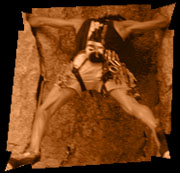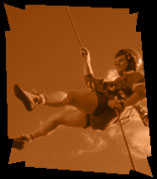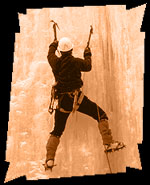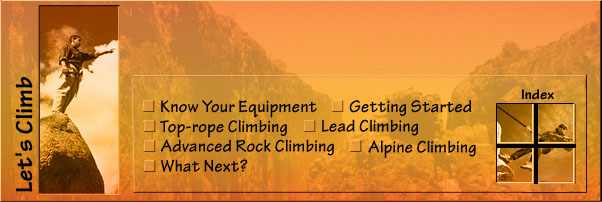
Know Your Equipment
 You do not need to buy any special equipment at the outset although you should wear appropriate clothes and footwear. Make sure your shoes can help you grip the rock. Your instructor will provide you with a harness and, if you are climbing outside, a safety helmet. You must wear this at all times.
You do not need to buy any special equipment at the outset although you should wear appropriate clothes and footwear. Make sure your shoes can help you grip the rock. Your instructor will provide you with a harness and, if you are climbing outside, a safety helmet. You must wear this at all times.In your first lesson you will be told about the importance of the rope, the harness and the belaying device (See Get a Foothold). Knowledge of rope handling is important for every climber. As you climb, another person 'belays' or secures the rope to protect you in case of a fall or a slip. One end of the rope is attached to your harness through a loop using a secure knot. The other end is connected to a belaying device clipped to the belayer's harness. It's useful to master knots and to understand how the equipment works. Your instructor will show you the knots you need. Learn how to do them properly.
Listen to your instructor and do exactly as he/she tells you if you want to climb safely. Concentration and a good sense of balance will help you as you climb.

Getting Started
 Technique
TechniqueClimbing is popular with women and girls as much as men and boys because it is more about balance than strength. If you learn to climb on an inside wall, there is usually a small area where you can practise hand holds, foot holds and bridging. Bridging involves learning to spread the weight of your body against the wall so that you are balanced. Your instructor will show you how to use your hands and feet to grip and push your body upwards while keeping your balance.
If you climb outside you will use the same techniques and your instructor will point out places that are appropriate to use as foot holds and hand holds. You must always wear a helmet outside for safety and if someone calls a warning always look down, never up!
Ratings
Outdoor climbs are rated according to their level of difficulty. Even on an indoor wall, there will be climbs with different levels of difficulty. As a beginner you will start with an easy climb and move onto more difficult climbs as your confidence and skill develops.

Top-rope Climbing
Climbing upOn an indoor wall or an outdoor climb, you will probably start with a top-rope climb. Your instructor will usually act as the 'belayer' while you climb. One end of the rope is attached to your harness with a special knot. The rope then passes through an anchor at the top of the climb, and finally the other end goes through a belaying device clipped to the belayer's harness. The anchor at the top of the climb is often assembled from loops of webbing connected to carabiners and attached securely to the rock by the instructor before you start climbing. On an indoor wall, the top anchor is fixed at the top of each climbing route.
When you climb, the belayer pulls on the rope to take up the slack. The belayer can stand at the bottom or the top of the climb depending on the situation. If you slip or fall, the belayer stops the rope with the belay device attached to his harness so that you only fall a few centimetres. You can easily re-establish your hand and foot holds if you slip.
 Getting down
Getting down
Walking
This is the easiest way to get down, especially from a top-roped climb. On some outdoor top-rope climbs you walk to the top of the climb first, abseil down the rock and then climb back up again!
Lowering
This is also called abseiling. In a top-roped climb, the belayer lowers you. As the belayer lets out the rope, you lie back so that your feet are flat against the rock face and your legs are fairly straight and at right angles to the wall. With your feet and body in this position you create a better friction between your feet and the wall and you have more control. You place your weight on the rope, and gradually descend.
When everyone is down, the rope is removed from the anchor and taken away with the rest of the equipment. Popular climbing areas have permanent anchors for regular climbers to use and your instructor may use one of these.

Lead Climbing
Climbing up As you move onto more demanding rocks or crags, you will find it is not always possible to carry out a top rope climb. There may not be a safe way to the top to set the anchor or perhaps the climb is so long, top-rope climbing is impossible because the rope isn't long enough. In this case, the lead climbing method is used.
As you move onto more demanding rocks or crags, you will find it is not always possible to carry out a top rope climb. There may not be a safe way to the top to set the anchor or perhaps the climb is so long, top-rope climbing is impossible because the rope isn't long enough. In this case, the lead climbing method is used.In lead climbing, there are at least two people working together - a leader and a follower. They climb in sections or 'pitches' that are shorter than the length of the rope. First the leader climbs the pitch, wedging pieces of protection into the rock and attaching the rope to them with carabiners. The follower acts as the belayer. At the top of the chosen section, the leader anchors himself/herself to the rock and belays the follower. As the follower climbs, he removes the carabiners and carries them to the start of the next pitch. The follower anchors himself here so that the leader can move on. In this way, leader and follower make their way to the top of the climb with the leader always covering each section first.
The leader's job is dangerous and falls can lead to injuries. A leader can fall twice the distance from the last stopping point before the rope holds him and he may hit rocks on the way down. Leaders, men and women, are usually very experienced climbers and their 'followers' will have spent many hours mastering the basic techniques on smaller climbs. This type of climbing is used by the majority of serious rock climbers. The more difficult the rock face, the greater the challenge. Some climbers even carry small hand drills to secure the carabiners and webbing to the rock face as they climb!
Getting down
Rappeling
This is similar to lowering except you control your descent. Before you climb a belay device is attached to your harness and the rope passes through this. As you descend, you let out the rope gradually through the belay device so that if you are going too fast you can halt your descent. If the anchor point is below you, as it can be on some climbs, you need to climb below it before you can used the rappeling technique.

Advanced Rock Climbing
On the steepest rock climbs, chocks may be used. These are devices that are wedged into crevices in the rock. The rope is attached to these using carabiners. Vertical and overhanging rock faces may also require use of short, ladderlike loops of nylon webbing. These are attached to the rock by the lead climbers. Following climbers can then use two mechanical ascenders that alternately grip and release the rope as the climber goes up, while standing in attached stirrups.
Advanced Alpine Climbing
 In steep snow and ice-covered routes, crampons and ice axes are used. Crampons are devices with 12 or more sharp steel points that are strapped onto each boot. Glacier routes require the use of slings and additional equipment so that a climber who falls into a crevasse may quickly climb or be hauled out.
In steep snow and ice-covered routes, crampons and ice axes are used. Crampons are devices with 12 or more sharp steel points that are strapped onto each boot. Glacier routes require the use of slings and additional equipment so that a climber who falls into a crevasse may quickly climb or be hauled out.

What Next?
If you are seriously interested in climbing, practise as much as you can. Become a member of a club and talk to experienced climbers and instructors. Join organised climbs to gain experience. The more time you give to this leisure pursuit, the more skilful you will become.

